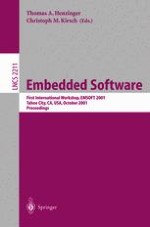2001 | Buch
Embedded Software
First International Workshop, EMSOFT 2001 Tahoe City, CA, USA, October 8–10, 2001 Proceedings
herausgegeben von: Thomas A. Henzinger, Christoph M. Kirsch
Verlag: Springer Berlin Heidelberg
Buchreihe : Lecture Notes in Computer Science
Enthalten in: Professional Book Archive
